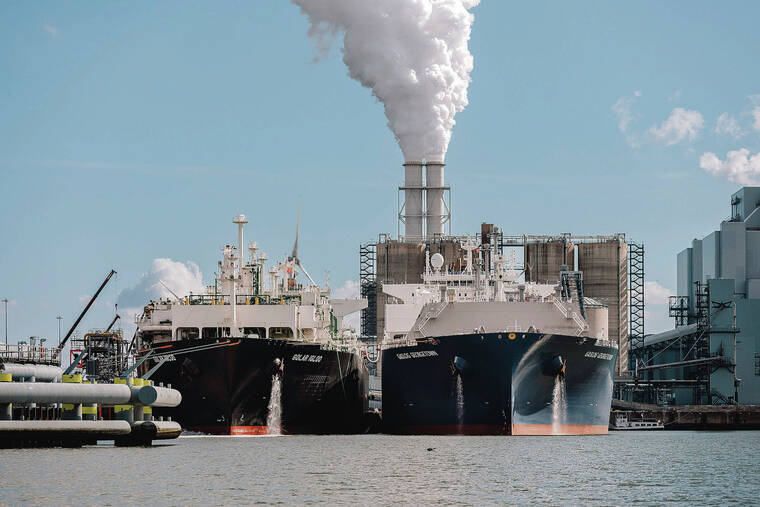Column: LNG poses too many risks; shift isles straight to renewables

Henry Curtis

NEW YORK TIMES / 2022
Ships at the port of Eemshaven, the Netherlands, pump liquefied natural gas brought from the Gulf Coast of the United States.


“It’s tough to make predictions, especially about the future.” — Yogi Berra
The Hawaii State Energy Office (HSEO) recently issued a study which found that liquefied natural gas (LNG) has the potential to reduce greenhouse gas emissions and reduce costs over a 20-year period. However, the study is limited when making long-term projections, and the study itself states that its analysis “depends on certain key assumptions and carries associated risks.”
LNG is natural gas that is mostly methane that has been cooled to minus 260 degrees Fahrenheit to turn it into a liquid, reducing its volume for easier storage and transportation. It is shipped in special cryogenic tankers and stored in insulated tanks to maintain low temperatures. After transport, LNG is converted back into gas, and in Hawaii it would be used to replace oil in generating electricity.
LNG would require costly infrastructure, such as an offshore platform for LNG tankers to dock and unload, storage tanks, pipelines and a regasification facility. HSEO estimates the infrastructure cost to be $1.4 billion. That’s quite a price, so before committing to LNG, there should be quite a bit of confidence that it would work.
The HSEO study relies on results that were generated by an energy model, the Greenhouse Gases, Regulated Emissions, and Energy Use in Transportation Model (GREET). It is the best available model, but it has limitations.
GREET is considered to be reliable in the short-term — five years or less. But in the long term — 10 years or more — uncertainty about the results increases substantially due to evolving conditions. The HSEO study uses GREET to make projections that support the adoption of LNG during a 20-year period, so its long-term projections should be considered with caution.
Don't miss out on what's happening!
Stay in touch with breaking news, as it happens, conveniently in your email inbox. It's FREE!
Furthermore, although GREET is continually updated with recent research findings, it does not yet include information from a recent extensive lifecycle analysis of LNG in the U.S. The analysis was conducted by Robert W. Howarth, whom the New Yorker Magazine called “one the world’s premier methane scientists.”
Since LNG is mostly methane, which is a gas at normal temperature, it can easily escape (compared to oil and other liquids) at every point along its lifecycle. The Howarth study totals all lifecycle emissions, including methane and carbon dioxide, such as the following:
>> Methane is released during drilling, fracking and other extraction processes. Pipelines, valves and other equipment may leak, and may be a large unintended source of methane.
>> Carbon dioxide is emitted by burning fossil fuels to power gas extraction.
>> Carbon dioxide is emitted from energy-intensive liquefaction plants that cool natural gas to minus 260 Fahrenheit.
>> Methane escapes during the transportation of LNG because the containers are warmed by the air.
>> Carbon dioxide is emitted when LNG is burned to create electricity.
>> Carbon dioxide is, of course, a greenhouse gas, and so is methane. But methane is 80 times more potent than carbon dioxide in trapping heat over a 20-year period.
According to Howarth, LNG may have a greater detrimental impact on the climate than oil when considering its full lifecycle. Since the HSEO study does not use data from the Howarth study, it may underestimate the climate effect of LNG.
The Howarth study raises too many uncertainties about LNG for Hawaii to confidently commit to it to replace oil. That is especially true because LNG requires costly infrastructure.
The $1.4 billion needed for LNG infrastructure would pay for rooftop solar on 70,000 homes. If LNG is tried and it fails, that money would be lost.
Instead, Hawaii should accelerate its transition directly to clean, renewable energy.
Henry Curtis is executive director of Life of the Land.



